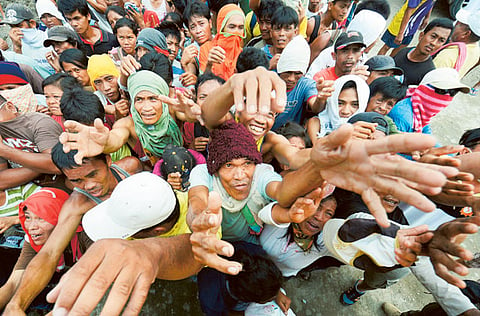Deadly typhoon Bhopa returns to northern Luzon
1,400 dead, 5.4 million displaced in southern Philippines

Manila: Heavy rain brought flooding fears in the north of the storm-battered Philippines as Typhoon Bopha returned on Sunday, days after slamming into the south of the country and leaving almost 1,400 dead or missing.
While the powerful typhoon had weakened to a tropical storm, it was still causing downpours in the north as hundreds in the south struggled to recover from its fury, said civil defence chief Benito Ramos.
“It will bring rain, not so much wind. We anticipate flash floods and landslides. We expect low-lying areas to be flooded again,” Ramos said.
Officials said 548 people are confirmed dead, most of them in the southern island of Mindanao.
Civil defence chief Benito Ramos said the number of missing had shot up to 827 from previous figures of 500 unaccounted for, after reports of more missing fishermen came in.
Nearly 5.4 million residents have been affected with P6 billion (Dh538 million) worth of damage caused to infrastructure and agricultural products in the southern Philippines, from December 4 to 5, officials said.
As soon as Typhoon Bopha was seen 85 kilometres west of Laoag City at 4am on Sunday, northern Luzon’s local government officials ordered the immediate evacuation of residents in coastal, low-lying, and landslide-prone mountain-side areas, to prevent what happened in the southern Philippines, said Ramos.
“We aim for zero number of casualties,” a local government leader from the north said in a radio interview, adding, “We have learned our lessons from what happened in the south.”
Bopha, now 800 kilometres away from where it initially unleashed its devastating power in the south, has weakened into a tropical storm, Its winds at 95km/h and gustiness of up to 120km/h, trailed northeast at a speed of 15km/h towards northern Luzon, said the government-run Philippine Atmospheric, Geophysical and Astronomical Services Administration (Pagasa).
Bopha’s 15 to 25 millimetres of rain per hour, within a diameter of 300 kilometres, already drenched provinces such as Ilocos Sur, Ilocos Norte, La Union, and Tuguegarao, said Pagasa.
Storm signal number two, the second of a three-level storm alert was raised on these three provinces. Storm signal number one was raised on Cagayan, Calayan Group of Islands, Babuyan Group of Islands, Batanes Group ofIslands, Abram Apayao, Kalinga, Mountain provinces, Benguet, Pangasinan, and Zambales (in central Luzon), said Pagasa.
Social and health workers, the military and the police in northern Luzon awaited Bopha’s wrath with confidence on Sunday, Ramos said.
It is expected to leave Aparri, in Tuguegarao, on Monday.
Bopha has been dubbed the Philippines’s strongest typhoon when it entered the northeastern part of Mindanao with 210km/h winds on December 4.
Twenty typhoons enter the Philippines every year.
Sign up for the Daily Briefing
Get the latest news and updates straight to your inbox



